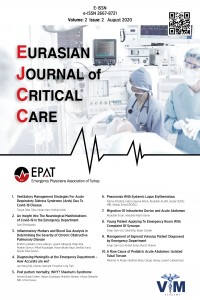Abstract
References
- 1-Santamaria-Alza Y, Sanchez-Bautista J, Fajardo-Rivero JE, Figueroa Pineda CL. Acute respiratory involvement in Colombian patients with systemic lupus erythematosus undergoing chest computed tomography. Int J RheumDis. 2019;22(10):1825-31.
- 2-Teh CL, Wan SA, Ling GR. Severe infections in systemic lupus erythematosus: disease pattern and predictors of infection‐related mortality. Clin Rheumatol. 2018;37(8):2081‐6.
- 3-García-Guevara G, Ríos-Corzo R, Díaz-Mora A, López-López M, Hernández-Flores J, Fragoso-Loyo H, et al. Pneumonia in patients with systemic lupus erythematosus: Epidemiology, microbiology and outcomes. Lupus. 2018;27(12):1953-9.
- 4-Musher DM, Thorner AR. Community-acquired pneumonia.N Engl J Med. 2014;371(17): 1619–28.
- 5-Lazovic B, Zlatkovic-Svenda M, Jasarovic D, Stevanovic D. Systemic lupus erythematosus presenting as acute lupus pneumonitis. Arch Bronconeumol. 2018;54(4):222-3.
- 6-Corte TJ, DuBois RM, Wells AU. Murray and Nadel’s textbook of respiratory medicine. In: The lungs and connectivet issue diseases. 5th ed. St. Louis, MO: Saunders Elsevier; 2010. p. 1398–429.
Abstract
A 19-year-old female patient, who was diagnosed with SLE but has not received treatment for 2 years, came to the emergency service due to fever and shortness of breath that has been frequent for several days. In her physical examination, inspiratory rales, expiratory elongation and wheezing were found, and non-contrasted computed tomography of the patient showed parenchymal infiltrative densities that were widely distributed in both lungs. The patient, who was recommended close follow-up for respiratory failure and acute respiratory distress syndrome (ARDS) by the department of pulmonology, was referred to the intensive care unit because of worsening of her clique. Infection is one of the most important causes of morbidity and mortality in patients with systemic lupus erythematosus (SLE). Lupus pneumonia, one of the respiratory system involvements of SLE, is especially seen in young women. High fever, cough, hypoxia and tachypnea are the most common symptoms and are associated with high mortality. In acute lupus pneumonia, systemic corticosteroid should be added to the treatment. If these patients do not improve dyspnea within 72 hours, methylprednisolone treatment is recommended. We present a 19-year-old female patient diagnosed with lupus pneumonia in the emergency service and referred to intensive care unit with the diagnosis of ARDS.
Keywords
References
- 1-Santamaria-Alza Y, Sanchez-Bautista J, Fajardo-Rivero JE, Figueroa Pineda CL. Acute respiratory involvement in Colombian patients with systemic lupus erythematosus undergoing chest computed tomography. Int J RheumDis. 2019;22(10):1825-31.
- 2-Teh CL, Wan SA, Ling GR. Severe infections in systemic lupus erythematosus: disease pattern and predictors of infection‐related mortality. Clin Rheumatol. 2018;37(8):2081‐6.
- 3-García-Guevara G, Ríos-Corzo R, Díaz-Mora A, López-López M, Hernández-Flores J, Fragoso-Loyo H, et al. Pneumonia in patients with systemic lupus erythematosus: Epidemiology, microbiology and outcomes. Lupus. 2018;27(12):1953-9.
- 4-Musher DM, Thorner AR. Community-acquired pneumonia.N Engl J Med. 2014;371(17): 1619–28.
- 5-Lazovic B, Zlatkovic-Svenda M, Jasarovic D, Stevanovic D. Systemic lupus erythematosus presenting as acute lupus pneumonitis. Arch Bronconeumol. 2018;54(4):222-3.
- 6-Corte TJ, DuBois RM, Wells AU. Murray and Nadel’s textbook of respiratory medicine. In: The lungs and connectivet issue diseases. 5th ed. St. Louis, MO: Saunders Elsevier; 2010. p. 1398–429.
Details
| Primary Language | English |
|---|---|
| Subjects | Emergency Medicine |
| Journal Section | Case Reports |
| Authors | |
| Publication Date | August 26, 2020 |
| Submission Date | March 31, 2020 |
| Acceptance Date | April 27, 2020 |
| Published in Issue | Year 2020 Volume: 2 Issue: 2 |


